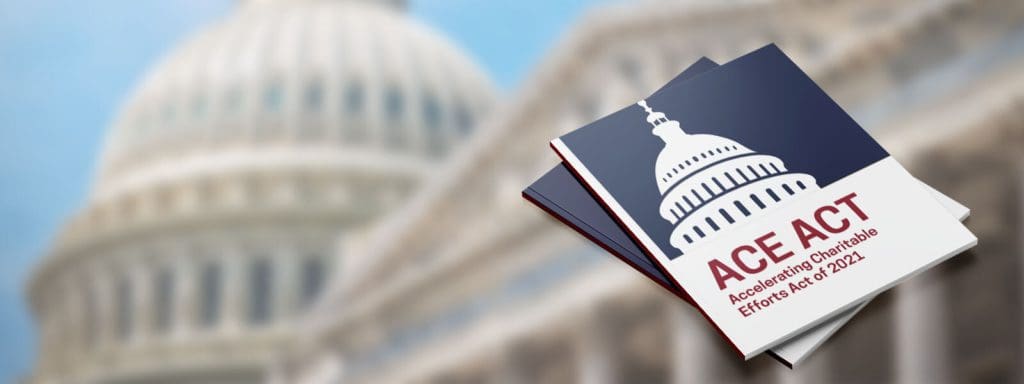Since October, Independent Sector has been holding a series of special online convenings about the Accelerating Charitable Efforts (ACE) Act, which is awaiting action in Congress. This legislation focuses on increased regulation of private foundations and Donor-Advised Funds (DAFs), a popular charitable giving vehicle. In 2020, as the National Philanthropic Trust reports, there were more than 1 million DAF accounts with more than $159.8 billion in charitable assets. Check out our bill summary for more background and details on the legislation’s “nuts and bolts.”
This special webinar series is designed to educate the sector, create a dialogue with experts, and hear from you about how the sector should approach these types of policies. IS has hosted three of our four convenings – the first three framed through the lenses of trust, equity, and resources. Our final convening on December 1 at 2:00 PM ET will focus on how nonprofits can navigate the tensions identified in the three previous convenings, including steps to help an organization decide whether or what position to take on the ACE Act and future philanthropy-reform proposals. To fully engage in this conversation, we thought it’d be helpful to review the highlights from the previous three convenings.
Trust
Our first convening analyzed the ACE Act from a perspective of public trust in philanthropy. Independent Sector’s recent Trust in Civil Society report found that institutional trust is declining, while proximity and familiarity are key to building trust. Our panelists explored whether current philanthropic practices live up to the expectations of policymakers and the public of our sector’s role in local communities. Some of the issues discussed included:
- To what extent some practices prevent private foundations from fulfilling the intention or spirit of the 5% payout rule;
- Concerns that a lack of transparency about funds flowing from private foundations and (DAFs) may leave the door open for abuse; and
- Whether DAFs that do not pay out on a regular basis could impact public perception of philanthropy.
Panelists were split on the ACE Act’s ability to increase trust in philanthropy, or whether policy change is even needed. Les Lenkowksy, Professor Emeritus at Indiana University and Senior Counsellor to the Dean at the Lilly Family School of Philanthropy, suggested that because the ACE Act addresses a small part of the philanthropic world, it’s unclear how much effect it would have on raising trust in philanthropy as an institution. In contrast, Jon Pratt, the recently retired leader at the Minnesota Council of Foundations, emphasized the ACE Act’s provisions on payout and reporting requirements as tools to increase trust by increasing transparency.
Equity
Our second convening, held during our Upswell Summit in October, examined the ACE Act from a perspective of equity. Our panelists discussed the intersection of equity and philanthropy reform and the extent to which the ACE Act addresses these challenges. Some of the issues discussed include:
- To what extent the structure of charitable giving incentives provides disproportionate benefits, and by extension influence, to high-income households;
- The need to accelerate the distribution of funds from DAFs to meet current inequities, as opposed to saving resources for future challenges; and
- How to enable the flow of philanthropic resources to a more diverse pool of charities, including organizations serving and led by people of color.
Laurie Paarlberg, Professor of Philanthropic Studies at Indiana University, noted that the lack of data on DAFs makes it challenging to evaluate how the ACE Act will impact equity. She noted that if we look at the data on past behavior of high-net-worth donors, there is no indication that the ACE Act will accelerate giving to marginalized communities. However, new data may signal this longer-term trend could be shifting slightly. A 2021 study by the Lilly School of Philanthropy showed 11% of high-net-worth donors reported making a donation to support Black/African-American causes (up from 7% the previous year) and one-fifth of respondents reported giving to racial or social justice issues.
Roger Colinvaux, Professor of Law at The Catholic University of America, and Marlon Williams, Vice President of Collaboration and Policy at Philanthropy New York, raised big-picture, systems-level questions about equity and philanthropy and our society. Williams challenged us to identify the specific aspects of inequity in philanthropy we’re trying to solve, and determine whether we’re using the right tool to address it. In other words – work backwards from the inequity, rather than try to determine whether existing legislation will achieve the goal. Colinvaux encouraged us to keep a narrow focus on the utility of the ACE Act. Specifically, to consider to what extent do we believe the bill makes the existing system better, not whether it solves broad systemic inequities. However, he noted philanthropy reform policies, including proposals to regulate DAFs, may impact what he called a “charitable racial wealth gap.”
Resources
Our third convening looked at the ACE Act from a perspective of giving flowing into philanthropy and the total resources available for grantmaking. Panelists discussed how proposed policy changes may impact donor behavior and the total amount of philanthropic dollars available for grantmaking. Some of the issues discussed include:
- The extent requiring donors to quickly distribute asset-based gifts from DAFs to charities may change giving behavior;
- Whether incentivizing private foundations to distribute funds at a scale that may reduce the amount of money available to grant in the future;
- The potential community impact of taxing DAFs that fail to distribute all of their resources in a pre-determined amount of time (15 years for qualified DAFs and 50 years for unqualified DAFs); and
- How the classification of anonymous donations from DAFs as from a single source rather than from multiple donors may impact charities’ ability to meet their public support test.
Panelists viewed the ACE Act with apprehension and optimism. Patrick Rooney, Professor of Economics and Philanthropy at Indiana University, cautioned that past economic analyses of donor behavior indicate that if policy makes it too difficult for donors to give, they might spend that money elsewhere. However, he acknowledged the value of some of the proposals to better align foundation payout practices with the spirit of the 5% rule. Christina McWilson Thomas, Director of Government Relations for the American Red Cross, expressed concern that supporting the ACE Act might be perceived as supporting a penalty against donors, rather than promoting transparency and equity within the sector. James Andreoni, Distinguished Professor of Economics at University of California at San Diego, noted that behavioral economics indicates deadlines can help encourage the action, like those proposed in the ACE Act that require grants to charities by a certain date. Deadlines encourage donors and foundations to make plans and envision how they will allocate money to charities every few years.
Up Next
While support was split on the ACE Act, everyone agreed that these are conversations the sector should be having. Discussions of philanthropy reform are not going anywhere. We have an opportunity as a sector to engage in hard conversations about the future.
Register now and join us on December 1 at 2:00 PM ET as we have another thought-provoking conversation, identify what was missing from our first three convenings, and consider the trade-offs in the legislation.
You can catch up on our previous convenings on trust, equity, and resources by viewing the webinar recordings. If you’d like to dive deeper into the ACE Act and philanthropy reform, explore our list of helpful resources.



